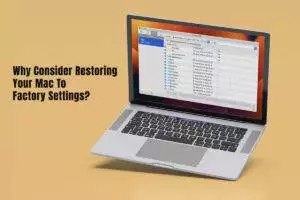Suppose you’ve ever found yourself frustrated with the sluggish performance of your Mac or puzzled by mysterious errors and glitches. In that case, it might be time to consider a game-changing solution – restoring your Mac to factory settings. In this article, we’ll explore why this can be a transformative step in enhancing your Mac’s overall performance and usability.

What Does Restoring to Factory Settings Mean?
Before we dive into the “why,” let’s clarify what it means to restore your Mac to factory settings. Essentially, it’s like hitting the reset button on your computer. When you choose this option, whether through the graphical interface or by using the command “factory reset Mac from Terminal,” you’re wiping the slate clean, erasing all the data and settings that have piled up since the day you unboxed your Mac. Applications, files, preferences, and configurations – they all go back to square one.
Eliminating Software Clutter and Performance Issues
Over time, your Mac tends to accumulate digital clutter. Think of it like a room that’s been neglected for too long – it gets messy, and performance suffers. Outdated applications, files you no longer need, and settings that have lost their purpose all contribute to this digital disarray. Restoring to factory settings, in essence, declutters your Mac, giving it a fresh start. It’s akin to tidying up your room, making it more organized and efficient.
Fixing Persistent Software Problems
Have you ever encountered software issues that just won’t quit? Those frequent crashes freezes, and applications that refuse to cooperate can be maddening. If you’ve tried everything to no avail, restoring your Mac to factory settings might be the silver bullet. It nukes any software-related problems that have been causing you headaches, delivering a clean slate for stable and trouble-free operation.
Enhancing Security and Privacy
In today’s digital age, the twin pillars of security and privacy are non-negotiable. Restoring your Mac to factory settings can play a pivotal role in safeguarding your sensitive information. By erasing every trace of your data and personal settings, you leave no breadcrumbs for potential snoopers. This becomes especially critical if you intend to sell or pass on your Mac, as it thwarts unauthorized access to your personal data.
Maximizing Available Storage Space
As the sands of time flow, your Mac’s storage can become choked with large files, duplicates, and applications that you’ve long abandoned. Restoring to factory settings opens the floodgates to reclaim all that previously occupied storage space. This newfound freedom can be priceless, particularly if you’re constantly locked in a battle against vanishing storage and the never-ending cycle of deleting files to make room for new ones.
Speeding Up Your Mac
Perhaps the most conspicuous benefit of restoring your Mac to factory settings is the quantum leap in speed and responsiveness. Picture this: Over time, numerous background processes and applications slowly put the brakes on your Mac’s performance. Restoring it to its factory state eradicates these bottlenecks, returning your Mac to its original swift and nimble self.
Reinstalling Only What You Need
Once you’ve restored to factory settings, you’re presented with a golden opportunity – to reinstall only what you truly need. This is akin to a clean slate, a fresh canvas for you to customize according to your current requirements. There’s no baggage here – no outdated applications or preferences lingering from the past. This paves the way for a streamlined and efficient computing experience tailored to you.
How to Restore Your Mac to Factory Settings
Now that we’ve explored the compelling reasons to consider restoring your Mac to factory settings, let’s delve into the step-by-step process. Here’s your comprehensive guide to get started:
Backup Your Data
First and foremost, before you embark on the journey of restoration, safeguard your precious data. Use reliable tools like Time Machine or an external storage device to create a secure backup of everything you want to preserve – your files, documents, cherished photos, and any other data you can’t afford to lose. This strategic move ensures that you have a lifeline to your valuable information after the restoration.
Sign Out of iCloud and Other Accounts
To prevent any complications during the restoration process, make sure to sign out of your iCloud account and any other accounts that are linked to your Mac. This important step helps ensure that your personal data and settings are safely disconnected from the device, preventing any unforeseen hiccups.
Access Recovery Mode
Now, let’s kickstart the restoration process. Begin by restarting your Mac. As it boots up, press and hold down the Command (⌘) and R keys simultaneously. This action will transport your Mac into the hallowed realm of Recovery Mode, where a treasure trove of utilities and system maintenance tasks await your command.
Erase Your Mac’s Hard Drive
Within the mystical confines of Recovery Mode, locate and select “Disk Utility” from the list of utilities at your disposal. Once inside, identify your Mac’s internal hard drive and take a deep breath as you choose the “Erase” option. Brace yourself, for this action will wipe away all data on the drive, leaving it a blank canvas, ready for the fresh installation of macOS.
Reinstall macOS
With your hard drive now a clean slate, bid farewell to Disk Utility and venture forth to select “Reinstall macOS” from the utility menu. Follow the breadcrumbs of on-screen prompts that lead you through the labyrinth of reinstallation. Your Mac, with an eager spirit, will take this opportunity to download the most recent and greatest version of macOS from Apple’s secure servers, giving itself a makeover.
Set Up Your Mac as New
As the phoenix of macOS rises from the ashes of your previous installation, you’ll be welcomed with the task of setting up your Mac as if it were fresh out of the box. This includes selecting your language, specifying your region, and creating a brand-new user account. Take your time here, configuring your preferences and settings to suit your individual needs and desires.
Restore Your Data
Once the groundwork is laid and your Mac stands reborn, it’s time to reintroduce your data into its digital life. Retrieve your backup – whether it’s from Time Machine or your trusty external storage device – and let your essential files and settings flow back into your Mac. This step is akin to rekindling old memories while enjoying the benefits of a rejuvenated and clean system.
